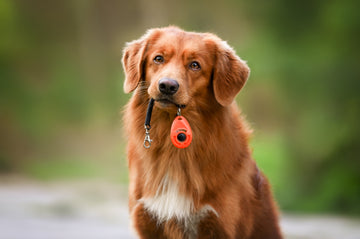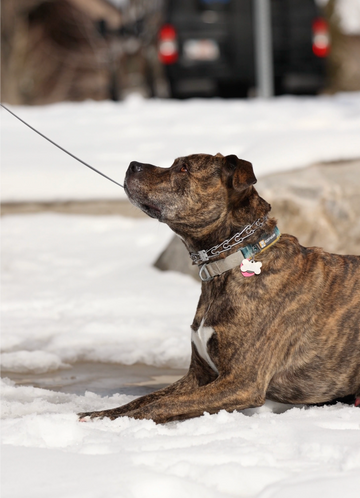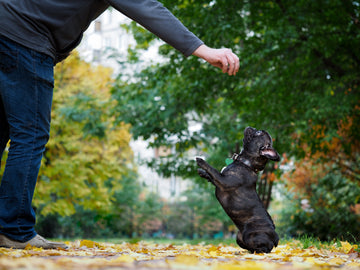
Owning animals, specifically dogs, can be a rewarding experience. With over 470 million dogs kept as pets worldwide [1] it’s clear to see that our canine companions have a special place in our hearts. But if you are looking to enhance that experience, building the foundation for clear communication is the best way to start. One of the easiest, and cheapest, forms of communication you can have is through a marker.
In this post, we will cover:
- What a marker is.
- How to “charge” or “load” a marker.
- How to use markers.
What a Marker Is?
A marker is a signal either a word or a noise used to record a moment in time when the dog performed an action. It could be wanted or unwanted behavior. In this post, we will focus on wanted behaviors, although the same principles can be applied to addressing unwanted behaviors.
At Pawsome DogSports, we utilize a marker as a terminal release reward marker (trrm). This signals the end of a behavior and signifies a reward for the dog, typically food or a toy.
Using a marker this way means you eliminate the need to teach a 'wait' or 'stay' as it is implied in the behavior. Once learned, the dog should maintain the behavior (sit, down, stand, etc.) until they are marked, released, or given a new behavior.
The two most common markers used are clickers or the word ‘yes’. The specific word or sound used is not important; the key is consistency in pairing it with a reward each time, even if the timing was not perfect on your part. Other common cues include ‘okay’, ‘good’, and ‘chip’.
The other type of marker that we use is called a terminal release marker. It is very similar to the terminal release reward marker, but you don’t follow through with a reward. Often, releasing the dog from behavior is rewarding enough. When released the dog is allowed to be a dog (sniff, roll in grass, chase butterflies, etc.). Common words used for this type of marker are ‘done’, ‘break’, ‘finished’, and ‘free’.
How to “Charge” or “Load” a Marker
Once you’ve decided what your marker (trrm) is going to be, you have to “charge” or “load” it. But what does that mean? Charging or loading it means we are giving a neutral thing a good meaning or adding value to it. For this post we will be using the word ‘yes’ as our marker and our reward will be food.
To start giving meaning to your marker you will simply say, “Yes” and give the dog food. For the best success in using a marker, we recommend existentially feeding your dog. For more insight into that please check out our post on Existential Feeding. The important thing is to reward the dog with something they want.
After approximately 50 repetitions, you will notice that you will be able to say, “Yes” and the dog will come to you expecting food. This is when you know you have a “loaded” or “charged” marker.
How To Use Markers.
Now that you have a charged marker, the next step is to use it to “capture” specific behaviors that your dog does that you like. If your dog already knows how to sit, you ask the dog to sit and the moment their bottom hits the pavement you would mark and reward. Think of your marker like a polaroid picture. It would look like this:

When you snapshot that moment, their bottom touched down with “Yes” that lets them know they have done the right thing. The reward helps reinforce the behavior which makes it more likely they will do the behavior the next time that it's asked for.
It is important to note that because we use markers in this way, your timing of rewarding the dog is not important, but the timing of your mark is. This means that once you have marked the dog you can take your time giving the reward to the dog. If you have charged your marker well, they will know that they have a reward coming. Don’t fall into the trap of getting the food before you mark or even sticking your hand in your Voilà Treat Pouch before you have marked. Otherwise, you will find the dog will think your hand and body gestures are the mark and not your words.
Initiate marking your dog for all desirable actions. This will reinforce your dog's behavior and increase their interaction with you.
The adage “all roads lead to Rome” is true with all of dog training, meaning there are many ways to get to the same result. There are many ways to use a marker, but this post describes the way we prefer as we find it helps bring a lot of clarity to the dog.
As always, if you and your dog are struggling seek help from a professional who can walk you through the steps in person, or marker train your dog for you. The most important thing is to get out there with your dog and have some fun!
References:
[1] Statista 2018, Statista website, Number of dogs and cats kept as pets worldwide in 2018, accessed March 6, 2024, < https://www.statista.com/statistics/1044386/dog-and-cat-pet-population-worldwide/#:~:text=With%20over%20470%20million%20dogs,pet%20cats%20in%20the%20world>.






